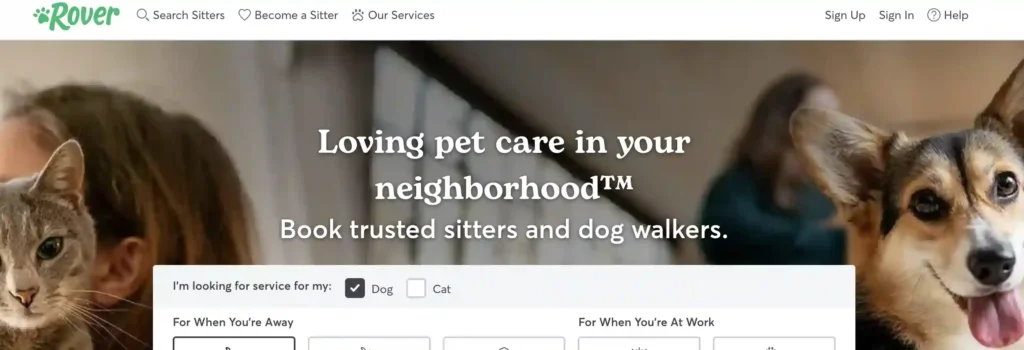Contents
What is Rover?
Rover is a U.S.-based platform that offers pet-sitting services for cats and dogs. It was established in 2011, with headquarters in Seattle (something I only discovered while writing this). Like many companies founded around the same time, Rover operates as a “gig work” platform. This means that the platform itself doesn’t provide the services directly but instead connects people who need services with those who can offer them. It’s similar to how Uber and Lyft “democratized” the taxi industry—anyone with a car who passes a background check can offer rides without needing to be a full-time employee of a taxi company, giving passengers more options and convenience. Likewise, Airbnb has disrupted the hotel industry by offering more varied accommodation options, and Doordash has expanded food delivery beyond what individual restaurants typically provide.
Rover works in the same way as these gig work platforms. Once an individual passes a background check, they can register as a cat or dog sitter, choosing the type of services they want to offer, setting their own schedule, location, and prices. Customers who need pet-sitting services can search for sitters based on location and the services they require. Rover then takes a commission on each transaction.
How to become a Rover?
First of all, working in the U.S. requires the appropriate work permits. Rover falls under the category of self-employment, and if your earnings exceed a certain threshold, you will receive a 1099 form at the end of the year to report your income for tax purposes. Before applying to become a sitter on Rover, make sure you have the necessary work permits, as not having them could lead to potential tax and immigration issues.
Submitting an Application on Rover.com
Most of the application process involves setting up your Rover profile. Similar to a dating app profile, the sole purpose of this information is to make people who need cat or dog-sitting services feel that you are trustworthy, caring, and capable of looking after their pets. In addition to writing about your pet-sitting experience, it’s a good idea to upload some photos of yourself interacting well with cats or dogs.

Additionally, you will be asked to submit your address so that the platform can match you with clients based on geographic location. This address won’t be shared with customers; it is only used in the background to calculate distance.
Background Check
The final step of submitting your application is authorizing and paying for a background check. The cost of the background check varies by location; for example, in Seattle, it was $35 for me, while a friend in the Bay Area only paid $25, likely due to different regulations or the vendor used. Since the background check is required, be sure to register with your real name. Also, when customers search for local Rover sitters, they will see your full first name and the initial of your last name.
References
After completing your registration, you can provide email addresses of friends, family, or people whose pets you’ve cared for to write reviews for you. These reviews will appear on your profile, helping you avoid having a completely empty profile when you first start. Keep in mind that the name of the person leaving the review will also be displayed on your profile. However, since there’s no need for real-name verification, if privacy is a concern, you can suggest they use an English name (though it’s not recommended to use usernames that don’t look like real names).
Selecting the Services to Offer
You can choose the services you’d like to provide either during registration or adjust them later at any time. Currently, there are five service options available:
- Drop-in Visits: Visit the client’s home to feed and care for their pets (like cleaning litter boxes). This is the only service I’m currently offering.
- Doggy Day Care: Care for the client’s dog during the day at your home, but without overnight stays.
- Dog Walking: As the name suggests, taking dogs for walks.
- Boarding: Provide overnight care for pets at your home.
- House Sitting: Stay at the client’s home to care for their pets, including overnight stays.
For each service, you can customize the following options:
- Active: Whether or not you’re offering this service.
- Away: You offer this service, but are temporarily not accepting clients.
- New customers: Whether or not you’re accepting new clients.
- Service pricing: You can set the price for each service. The app can also automatically adjust your rate for holidays. For example, I had a booking over Thanksgiving, and the app automatically added a few extra dollars for a holiday rate.
- Maximum number of visits per day: Set how many visits you can handle in a day.
- Days of the week you’re available: Specify which days of the week you can provide the service.
- Time slots for services: Set specific times you’re available each day (I only chose 11am-3pm & 3pm-10pm, but I still receive inquiries for 9am bookings. You can choose whether to accept these, and declining them won’t affect your booking rate).
- Booking and cancellation notice: Set how much notice you require for bookings and cancellations.
- Service area: Specify how far from your home (in miles) you’re willing to travel.
- Accepted pet types: Choose which types of pets you accept. For example, I selected cats, and for dogs, you can specify size categories (I opted not to accept dogs over 100 pounds). You can also choose whether or not to accept puppies under 1 year old.
My One-Week Experience
Since it was right around Thanksgiving, I quickly received a few bookings. In the end, I accepted two long-term cat-sitting jobs that spanned the week before and after Thanksgiving, balancing the clients’ needs with my own schedule.
What I Enjoyed
- Getting to cuddle with other people’s pets: It’s so fun to spend time with different cats and observe their unique personalities.
- Surprisingly, I can earn money!: Although the income isn’t much, it’s amazing that I get paid to pet cats. Considering that people pay to visit cat cafes, this feels like a great deal!
- Less human interaction: Compared to driving for rideshare services or delivering food, there’s much less interaction with people, and I also spend less time driving. It’s relatively safer and more suitable for someone who’s socially anxious.
- Low entry barrier: For drop-in visits, I didn’t need to prepare anything myself—no need to verify a vehicle, house, etc. Everything, including the background check, was done online, making it easy to get started.
- Discovering different homes and neighborhoods: I’ve had the chance to see local homes and neighborhoods I wouldn’t usually visit. For example, the caramel cat lived near the seaside, and I ended up exploring a seaside park I hadn’t been to before. Normally, I’d avoid this kind of park because it’s not very convenient to park nearby, and it’s a bit out of the way.
- More structured routine: Unlike ridesharing and food delivery, which can be very random, these visits require advance scheduling. This has helped me get out of the house more regularly and has been a good way to avoid worsening seasonal depression during the winter.
What I Didn’t Like
- Loss of flexibility: While the structured scheduling can be a plus, it also becomes a drawback because it limits spontaneous plans. I usually enjoy being able to go out on a whim, but with Rover bookings often made far in advance, I lose that freedom. If I don’t book, I feel like I’m missing out on potential income, but once I book, I’m tied down and can’t just go out whenever I want. This lack of flexibility is something I really don’t like.
- Highly seasonal demand: The demand is very seasonal. I got a lot of bookings during the holidays, but outside of that, things dried up (at least when I first started). After the Thanksgiving rush, I blocked off time for New Year’s, and I didn’t receive any inquiries at all in between. This, combined with the lack of spontaneity, makes me feel like I’m tied down by someone else’s pets rather than my own, restricting my ability to travel or plan outings freely.
- Low earnings: The pay isn’t great. Rates vary by region, and I initially followed the app’s suggested pricing—$15 per drop-in visit. After the platform’s fee, I’d earn around $12 per visit. Even though each visit is supposed to be 30 minutes, I still have to account for travel time and potential traffic. For example, going to the caramel cat’s house, from getting dressed and heading out to returning home, would take almost an hour, which puts my earnings close to minimum wage. This doesn’t include parking, gas, or the extra time spent on meet-and-greet sessions to pick up keys.
- Less automation: Booking with clients involves messaging back and forth, negotiating times, and sometimes meeting in person for a key handoff. This is far less automated compared to ridesharing or food delivery, where everything is streamlined and requires minimal interaction.
Conclusion
After 9 days on Rover, I completed a total of 22 visits, which I estimate to have taken around 20 hours of work. After the platform’s fees, I earned $334.40, but with the $35 background check fee and around $5 in parking, my hourly wage was roughly $14.70—less than the local minimum wage. Considering that non-holiday periods have even fewer bookings, it’s hard to imagine this becoming a sustainable way to make money. To make it work, I’d probably have to offer boarding services or walk multiple dogs at once to maximize time efficiency.
For now, I don’t think I’ll be taking on more Rover gigs anytime soon. If I want to earn some extra income with more flexibility and human interaction, ridesharing might be a better fit (though car inspections can be a hassle). If I prefer something with less social interaction, I might look into food delivery instead. If anyone has suggestions for other types of gig work, feel free to share!




